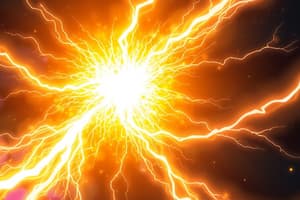Podcast
Questions and Answers
What happens when a negatively charged rod is brought near a neutral metal sphere?
What happens when a negatively charged rod is brought near a neutral metal sphere?
- The protons in the sphere move away from the rod, making the side of the sphere closest to the rod negatively charged.
- The electrons in the sphere move away from the rod, making the side of the sphere closest to the rod positively charged.
- The protons in the sphere move towards the rod, making the side of the sphere closest to the rod positively charged.
- The electrons in the sphere move towards the rod, making the side of the sphere closest to the rod negatively charged. (correct)
Which of the following is NOT an example of charging by conduction?
Which of the following is NOT an example of charging by conduction?
- Holding a charged object close to a neutral object. (correct)
- Connecting a charged battery terminal to a neutral wire.
- Rubbing a balloon on your hair.
- Touching a charged metal sphere with a charged rod.
Which of these statements accurately describes the difference between an ammeter and a voltmeter?
Which of these statements accurately describes the difference between an ammeter and a voltmeter?
- An ammeter measures the flow of charge through a circuit component, while a voltmeter measures the potential difference across the component. (correct)
- An ammeter measures the potential difference across a circuit component, while a voltmeter measures the flow of charge through the component.
- An ammeter measures the voltage in a circuit, while a voltmeter measures the current.
- An ammeter is connected in parallel with the circuit component, while a voltmeter is connected in series.
Which of the following is a good conductor of electricity?
Which of the following is a good conductor of electricity?
Flashcards
Like Charges Repel
Like Charges Repel
Objects with the same charge push away from each other.
Opposites Attract
Opposites Attract
Objects with opposite charges attract each other.
Charging by Conduction
Charging by Conduction
Transferring charge by direct contact. When you touch a charged object to a neutral object, electrons move from the charged object to the neutral object, resulting in both objects having the same charge.
Charging by Friction
Charging by Friction
Signup and view all the flashcards
Charging by Induction
Charging by Induction
Signup and view all the flashcards
Study Notes
Electrostatics Principles
- Like charges repel each other.
- Opposite charges attract each other.
Charging Methods
- Conduction: Transferring electrons from a charged object to a neutral object, resulting in both objects having the same charge. (Example: Rod to sphere)
- Induction: Rearranging charges in a neutral object without direct contact. Electrons shift within the object when a charged object is nearby. (Example: Balloon to wall)
- Friction: Transferring electrons between two different materials when rubbed together, one becomes negatively charged and the other positively charged. (Example: Balloon to sweater)
Definitions
- Charging by Conduction: Charging an object by touching it with a charged object, transferring electrons.
- Charging by Friction: Charging an object by rubbing it against another object, resulting in electron transfer.
- Charging by Induction: Charging an object without physical contact, using electrostatic forces to rearrange charges.
Electrical Measurements
- Ammeter: Measures electrical current in a circuit. Placed in series.
- Voltmeter: Measures voltage (potential difference) across a component in a circuit. Placed in parallel.
Electrical Quantities and Laws (Formulae Missing)
- Voltage (V): Electrical potential difference (measured in Volts).
- Current (I): Flow of electric charge (measured in Amperes).
- Resistance (R): Opposition to current flow (measured in Ohms).
Material Properties
- Conductors: Materials that allow electric current to flow easily, due to free moving electrons. Examples include copper.
- Insulators: Materials that limit or block the flow of electric current, due to lack of free moving electrons. Examples include rubber.
Studying That Suits You
Use AI to generate personalized quizzes and flashcards to suit your learning preferences.




